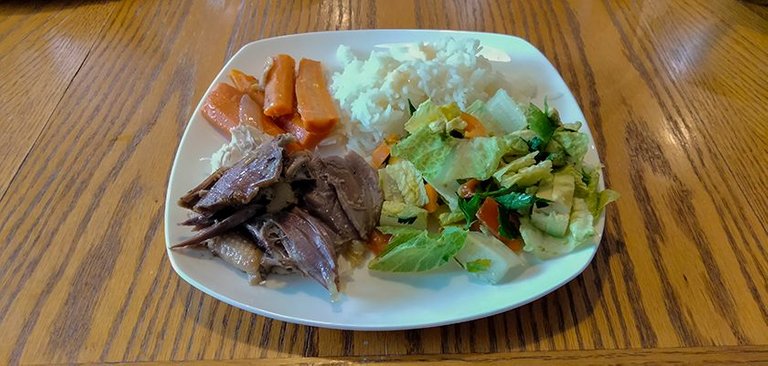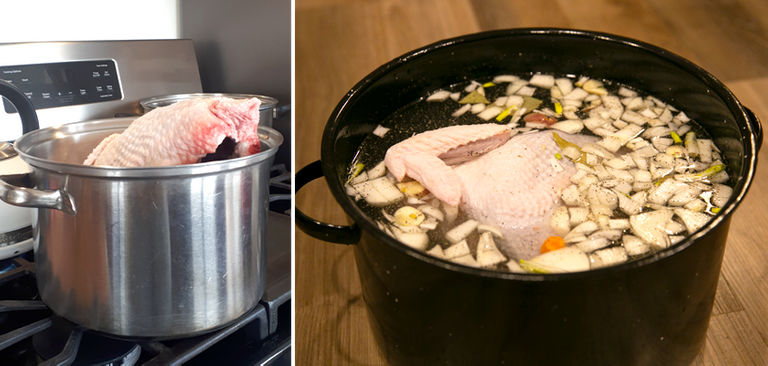By Mrs. Canadian Renegade
When we decided to rescue the chickens from my friend we had no idea how many where roosters and how many were hens; we ended up with 16 chickens and a third of them ended up being roosters. Right away, we saw problems with the roosters being aggressive with each other. Before long, one rooster was culled and on the table later that week. At that time, I learned about needing to rest the chicken.

Mama Renegade suggested leaving the chicken in a cold brine for a few hours and then left to rest in cold water, in the fridge for 24 to 48 hours. The salt would help draw out any extra blood that remained in addition to tenderizing the meat. Typically, store bought chickens are only 8 weeks old or less so their meat is already tender. The older a chicken is, the tougher the meat. The resting time would also allow the rigor mortis to pass which also contributes to better meat quality. I, however, misheard the instructions and let the chicken rest in the brine for 12 hours and then in the pot and refrigerated for an addition 12 hours.

After the resting period, I slow cooked the chicken for maximum tenderness and it turned out rather well. The following day I used the bones to make stock then added in the remaining meat and vegetables for a hearty chicken soup. Matt went so far as to say it was the best chicken soup he'd ever had [insert applause] but I felt like it was missing something. Either way, resting the chicken seemed to be key.
The second rooster to leave the coop ended up being rehomed with @alexander farm and you can see how he's doing here. But, unfortunately, the coop was still unsettled and there was a lot of bullying happening from one rooster in particular.
Matt had been putting off culling this rooster because he needed to work on other projects and this inadvertently worked in our favor when we heard a neighbour had set up to cull seven of their own roosters and we managed to get ours in the line up (Not to brag, but we actually have the best neighbours).

This time, I did more research and prepared a brine specifically for the resting period. My pot was far too small for this particular bird so after grabbing a pot from the neighbour I set to work on the brine.
Chicken Brine
2.5 Gallons Water
3/4 C Kosher salt
1 Tbsp Black pepper (Though I would use peppercorns next time)
3 Bay leaves
3 oz Brown sugar
2 Large carrots, roughly chopped
2 Medium onions, roughly chopped
3 Large cloves garlic, smashed
The pot was much too large for my fridge. I ended up using very cold water for the brine and then storing in the cold storage room in the basement for 48 hours.
Culling extra roosters is never an enjoyable task and we do our best to honor the roosters by getting the most nutrition from them we can. After the brining period I managed to make two meals from the chicken; slow cooker chicken and chicken soup. Come back to the blog to see how those recipes turned out. Spoiler alter: They were delicious.
So you actually ate him!????!!! Shock. Have you heard our recipe for a free range rooster @canadianrenegade? Cook for three days in a big pot of water with veggies and spices and a brick. After three days, throw the chicken away and eat the brick..... it's a standing joke of my Dad. And we just culled 24. Yup. THAT many. We gave almost half away but I've filled my freezer. And when I can stomach the job I'll make batches of chicken broth and slow cooked soup. I'm intrigued with your brining trick. I'll try that. Next time. In about 5 years time. Gulp
We did eat him, and I bet he tasted better than the brick. Truthfully, I have a hard time taking the life of an animal but I also know how beneficial eating them is for our bodies. I think it's good to feel sad though, because it reminds me that I am connected to where my food comes from and that I have a responsibility to care for the animals and make sure they are used to their fullest potential. -Aimee
Absolutely!!!
Thanks for sharing this Aimee! We’ll need to do this for our big ol’ rooster when it’s their time. Maybe sooner rather than later. 😬
Your welcome. The recipe I found used a quarter of the water but I didn't want to use 4x the onions and carrots. I think these quantities worked out just fine. They were seriously delicious meals and I am going to share more in future posts. -Aimee
We have only heritage birds and they are 18 weeks old when they go to Freezer Camp. We leave them in the cold room at 38F - 40F for up to 3 days before processing them for the freezer.
The old layers at 18 MONTHS all turn into ground chicken. We used a lot of ground chicken. And I would make enough chicken stock of the carcasses for a whole year and freeze it.
We processed all the birds, up to 90, the first weekend of September each year.
Thanks for sharing. What other steps to take for processing between the cooling and freezing period? At that point, is it just packaging?
Yes, this bird was somewhere between 12 and 18 months. Grinding the meat makes sense but maybe not for just one bird, unless you have the equipment yourself. Just like this brine wouldn't be optimal if you had multiple old birds to rocess at one time.
90 birds is quite the undertaking. My mother-in-law grew up processing 150 chickens every year on their homestead. They did it over 2 days. How long does 90 take you? -Aimee
We could usually do them all in one day with a 9AM sharp start. We usually had several people come in to help.
Our procedure is: bleed out in cones, into the scalder at 150F just until wing feathers loosen, into barrel plucker with 2 - 3 at a time, back to scalder to do feet, into butcher shop (a clean room) for evisceration, to the sink for washing and pin feather removal, to the scale to record weight/age/sex/breed, to the cold room and into huge tubs of ice water, after 20 mins into plastic bags in huge coolers. These are left open and the cold room stays between 38F - 40F for 3 days.
Then we bring a bag at a time into the butcher shop and they are cut up according to what we need for the year: boneless breasts and thighs, drumsticks, bone-in breasts and thighs, legs, and some whole birds, usually the biggest ones. The packages are all weighed again so we know exactly how much we put away in the freezer.
Then my husband would strip all the carcasses and that would be ground. All old layer carcasses were stripped and ground. Packaged ground in 1 lb bags. Then I spend the best part of a week making bone stock and freezing it. Then we are done for the year.
Wowza! That's a lot of work but so worth it for a year of meat and broth!
Wow! That sounds like a very full two days but worth the effort for a year of meat and chicken stock. Thank you for painting a picture of your process. -Aimee